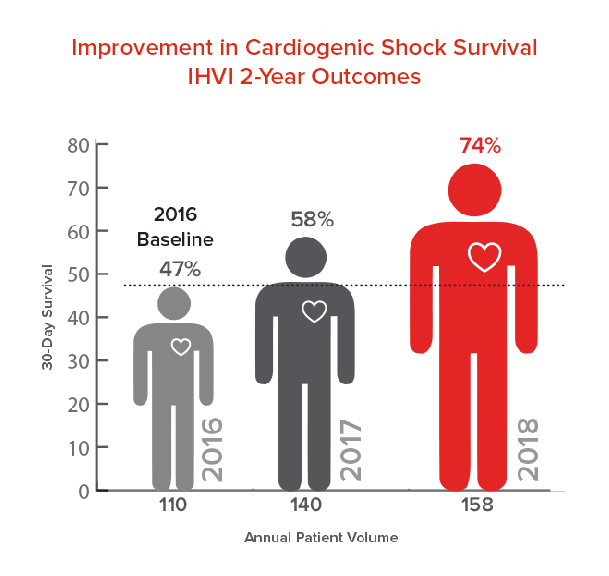The number of patients with cardiogenic shock across the country has increased and it is clear that timely decision-making and intervention are critical to survival.
Nationwide, half of all patients who experience CS die – a rate that has held steady for nearly two decades. But at Inova Heart and Vascular Institute in Falls Church, Va., a standardized, team-based approach has dramatically improved outcomes. Just two years after deploying the Shock Team, our 30-day survival rate rose to 74 percent. In human terms, this means 67 more people are alive today thanks to our innovative, multidisciplinary model. IHVI is the first medical center in the country to report these blockbuster results.¹
What is cardiogenic shock?
CS occurs when the heart cannot pump enough blood to meet the body's needs. It typically happens after a sudden cardiac event, such as a heart attack. Untreated, CS can quickly progress to multi-organ failure. About 1 in 10 people who experience a heart attack develop CS, and the mortality rate in the United States exceeds 50 percent. It is the most common of in-hospital mortality following a heart attack.
Deploying the Shock Team
IHVI's dedicated Shock Team provides timely decision-making and intervention critical to patient survival. A single phone call unites specialists from interventional cardiology, cardiovascular surgery, advanced heart failure and critical care to quickly gather information and recommend the best treatment for these critically ill patients.
Our successful CS protocol features:
- Rapid diagnosis
- Immediate, collaborative decision-making
- Early hemodynamic assessment and expedited initiation of mechanical circulatory support
- Minimizing vasopressor and inotrope use
- Heart recovery and survival
Standardized care improves outcomes
In our initial analysis, we found that factors such as fractured care, late detection, impaired access and practice variations contributed to high CS mortality rates. We recognized the opportunity to improve outcomes with timely diagnosis and a standardized algorithm across our “hub and spoke” network. Physicians at our regional centers call the CS line to activate the Shock Team at our hub hospital. There is no significant increase in mortality for patients transferred from another facility.
When the Shock Team began in January 2017, our CS patients' survival to 30 days post-discharge was 47 percent. But those rates swiftly increased to 58 percent by the end of 2017, and 76.6 percent in 2018 (see graphic).

Creating a national model
Our Shock Team algorithm is both a new approach and a practical one. We have the ability, right here on site, to deliver this lifesaving care. The model is easily replicated elsewhere.
Implementing a coordinated, regionalized system of care; embracing a standardized approach; establishing a CS care center with a multidisciplinary Shock Team and shock care protocols; and ensuring fast diagnosis and intervention are all critical elements.
These dramatically improved survival rates establish a validated model and new benchmark for other heart centers around the country.
References
¹Tehrani, B.N., et al, (2019). Journal of the American College of Cardiology, Volume 73, Issue 13, April 2019 DOI: 10.1016/j.jacc.2018.12.084

